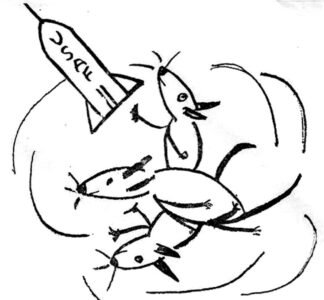Reporter’s Notebook: Tools of the trade

(Reporter's Notebook by Steven Allen Adams - Photo Illustration - MetroCreativeConnection)
I had the great pleasure to go to the Media Innovation Center at West Virginia University last week and attend an enlightening presentation on the use of AI (artificial intelligence) in news reporting.
You hear a lot today about artificial intelligence, or AI. Just about every digital product or electronic device advertises some AI feature. There are AI-generated news stories now, AI-generated images, videos, and even podcasts.
AI has the same problem that many different phrases have in that it has become an empty bag one can put whatever they want into it. Ask five people what AI is and you’re likely to get six different answers. And a lot that is categorized as AI isn’t really AI. It’s as much of a marketing term as anything else.
And in some, AI may conjure up images of Skynet from the Terminator franchise, or that Steven Spielberg/Stanley Kubrick movie from 2001. For others AI is the new economic engine, bringing with it the growth in data centers filled with servers that use almost obscene amounts of electricity. West Virginia just passed a bill meant to spur growth of data centers in the state, along with the potential for microgrids to power those centers, though criticisms of that new law remain.
I have never been a luddite, or someone who opposes new technologies, especially when it comes to journalism. I was one of this state’s first bloggers, doing so before the word blog – web log – was a thing. I was an early adopter of Gmail back when that was invite-only. I had Facebook before it was made available for the public at large. I quickly joined Twitter (now known as X) back in 2008. I was livestreaming press conferences before that became commonplace.
Even today, I rely on technology for my news reporting. I take photos with an iPhone among other things, such as recording interviews and taking notes. During the legislative session, it’s not uncommon for me to have my desktop Mac recording a Senate committee, my MacBook recording a House committee meeting, while I am running to do an interview.
But I’ve been slow to fully embrace AI in my reporting beyond the use of search engines and transcription software that I can drop my audio recordings into. I’ve heard too many horror stories of over-reliance on AI by some newsrooms and reporters. Some newsrooms use AI programs to write news stories or generate images without any kind of disclaimer. In some cases, AI programs have invented whole quotes and facts out of nothing, sometimes called an AI hallucination.
My friend Ashton Marra, a former statehouse reporter for West Virginia Public Broadcasting and former host of The Legislature Today, is now a teaching associate professor at the Reed School of Media and Communications at WVU. When she told me her students in her Experimental Journalism class would be studying AI, I was very skeptical. But she urged me to withhold my judgement until their class experiment was complete.
Her class completed their AI experiments, focused on the 2025 legislation session and different ways to cover it using AI. The students asked six questions: can AI generate a news story from a speech; can AI adopt/mimic the style of a real journalist; can AI effectively cover arguments of a politically charged debate; can AI accurately summarize complex legislation; can AI effectively adapt message for specific audiences; and can AI shorten the time it takes to prep for reporting.
All six experiments had various results. AI was useful for quickly analyzing information, such as draft legislation or speeches. It could provide succinct summaries of committee meetings and debates. It is also useful for helping a reporter quickly put together the skeleton of a story, allowing the reporter to add other information.
On the other hand, the information produced by AI was only as good as the information the reporter inputs into the AI program, and too much information can cause the AI program to become confused. AI programs can sometimes invent something out of nothing (hallucinations). It can mimic different reporter writing styles, but it couldn’t replace. It can show political bias depending on what information is being inputted.
At the end of the day, use of AI still involves a human fact-checking and providing the experience and context that an AI simply cannot do. A reporter with vast experience in statehouse reporting is still going to write a better story than AI can do on its own.
The Experimental Journalism students at WVU put together a wonderful presentation with smart tips for newsrooms and reporters. And they used the work of several statehouse reporters, including myself, in their experiments to see if the AI programs could replicate our style or create issue-specific newsletters based on our reporting.
While these students were conducting their experiments, I was using an AI program myself to quickly analyze draft legislation and amendments. I used Google NotebookLM, taking the text of an introduced bill and dropping it into the program to get a quick summary and create a briefing document to further explain a bill.
I could drop in a bill and any approved amendments or committee substitutes to the bill and ask NotebookLM to explain to me the differences and what was updated. I could also drop in transcripts from committee meetings and floor sessions, and it would highlight and summarize the arguments of bill proponents and opponents.
I never used NotebookLM to write stories. I only used it as a research tool. I also didn’t rely on NotebookLM’s summaries. I still had to listen to committee meetings and floor debates. I still needed to read the bills and amendments. I still needed to go to State Code to see what was currently in state law and see what was being changed. And I still needed to rely on my statehouse experience, including the nearly last seven years as your state government reporter.
The use of AI tools will continue to increase, and technology is always improving and changing. We can’t be afraid of it. AI is the latest tool in the toolbox. I’m just glad that we have student journalists at WVU thinking about these issues and providing a guide.
Steven Allen Adams can be reached at sadams@newsandsentinel.com






